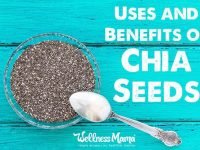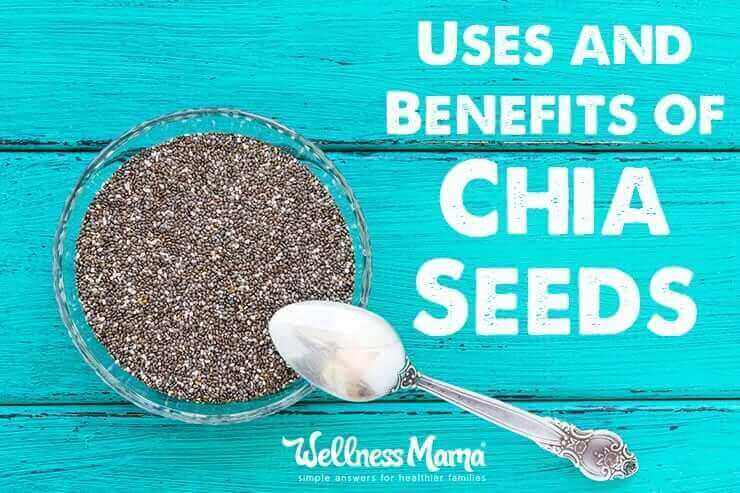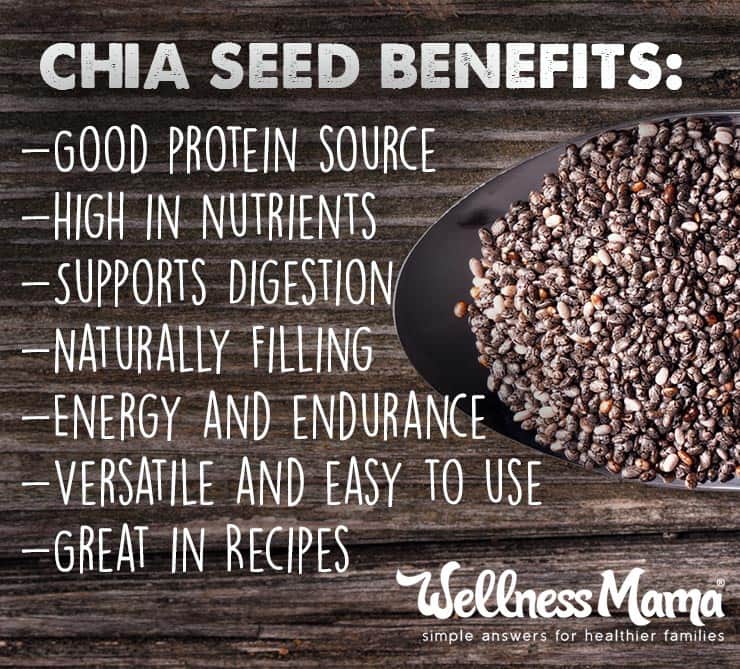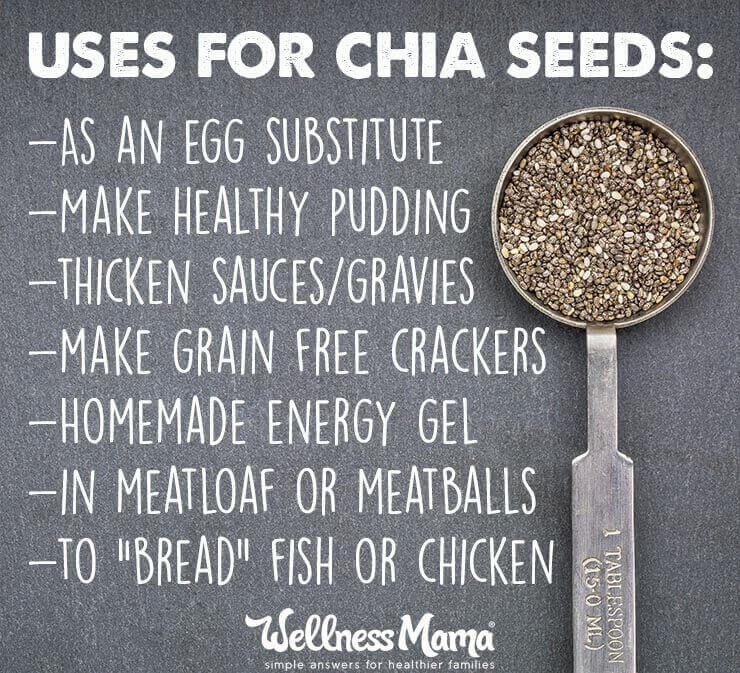

I’ve been using chia seeds in drinks and as an egg substitute in recipes for years. In fact, we just had homemade chia seed pudding with lunch today. While chia seeds can be an incredibly useful ingredient, especially for egg free or gluten free families, there is also a lot of conflicting information about these little seeds.
What are Chia Seeds?
Salvia hispanica, or the chia plant, is a species in the mint family that is native to Central America. The seeds of this herb are known as “chia seeds” and they have gained quite a bit of popularity in recent years.
Not only are they gluten/grain free naturally, but a single serving is reported to have:
- as much calcium as a glass of milk
- more Omega-3s than a serving of walnuts
- as many antioxidants as blueberries.
They give you tons of energy but also won’t keep you awake at night and are supposed to be great for weight loss. Because they can absorb many times their size/weight in liquid, they are great for avoiding dehydration during exercise or exposure to heat.
Are Chia Seeds the Original Superfood?
Chia seeds have a fascinating and long history of use by several cultures. I’m hesitant to use the word “superfood” because the word is so over-used in modern times and also because there are some confounding factors that may inhibit nutrient use.
Supposedly, the Aztecs, Mayans, and Incans used chia as a staple of their diet and as an energy food. Chia means “strength” in the Mayan language, and they were known as the “Indian Running Food” because runners and warriors would use them for sustenance while running long distances or during battle.
Though these ancient cultures may not have completely understood the nutritional breakdown of these power-packed seeds, they noticed the benefits, and we now know that chia seeds are a good source of:
- Essential Fatty Acids
- Protein
- Vitamins A, B, E and D
- Minerals like calcium, phosphorus, potassium, iron, copper, zinc, magnesium, manganese, niacin, thiamine, and others
- Antioxidants

Benfits of Chia Seeds
Small but mighty, chia seeds have a variety of benefits (and a few cautions!) and are considered by many to be one of the healthiest foods on the planet.
1. They Are A Great Source of Protein
The chia seed is a great plant source of protein, containing 4.7 grams of protein per ounce. They contain all eight essential amino acids, a rarity for a non-animal based food and are much higher in protein than many other plants. They still don’t compare to animal-based proteins, but especially considering the other beneficial properties of chia seeds, they are worth consuming regularly.
2. Packed with Other Nutrients
Don’t let their tiny size fool you… chia seeds are a big source of many nutrients!
Just two tablespoons (about an ounce) contains 10 times the Omega-3s of an equal serving of walnuts, more iron than a cup of spinach and a host of other nutrients in smaller amounts. They are also a great source of beneficial fats, fiber and about as many antioxidants per serving as blueberries.
In fact, chia seeds contain the highest level of Omega-3s of any known plant. It is important to note that they contain Alpha Linoleic Acid (ALA) form found in plant foods but not docosahexaenoic acid (DHA), the form found in fatty fish.
The body can convert some ALA to DHA, but it is relatively inefficient at this process, so ideally, we should consume both ALA and DHA from food sources.
3. Support Digestion
There are several unique properties of chia seeds that make them beneficial for digestion. They are an excellent source of fiber at 11 grams per ounce. In fact, of the 12 grams of “carbohydrates” found in chia seeds, 11 are from fiber, which is indigestible to the body and which does not raise blood sugar or affect insulin levels like other forms of carbohydrates.
Essentially, the net carbohydrate in the chia seed is only 1 gram per ounce, making them a naturally low-carb and high-fiber food, with one serving providing the recommended daily amount of fiber. This fiber works as a pre-biotic in the digestive system, so while it isn’t digested and used directly, it feeds the beneficial bacteria in the gut and may help improve gut health.
Chia seeds also have a unique ability to “gel” due to the soluble fiber content and the fact that the outer shell is hydrophilic and has the ability to absorb over 10x their weight in liquid. This makes them filling and satisfying. Researchers think that this gel action also occurs in the stomach, creating a barrier between carbohydrates and enzymes in the stomach which slows the conversion of carbohydrates into sugar. This may account for some of the reported endurance benefits of chia seeds.
I’ve listed a few of my favorite recipes below that show how our family uses chia seeds, especially for breakfast.
4. Natural Appetite Suppressant
Chia Seeds are often recommended for those who are trying to lose weight Their ability to expand and slow digestibility helps keep a person feeling fuller longer. (source)
Additionally, as a good source of both protein and antioxidants, they may nutritionally support the body in other ways that promote weight loss. Due to their hydrophilic properties, chia seeds also promote hydration, which is important for maintaining a healthy weight.
Though the research is mixed on chia’s ability to directly promote weight loss, experts seem to agree that they are a great addition to a healthy diet and for those of us with kids who are hungry all the time, they are an easy (and filling) addition to many common foods. I love to serve some form of chia seed pudding for breakfast since it helps keep my kids full until lunch.
5. Promote Energy and Endurance
The Mayans and Aztecs originally used chia seeds for their energy and endurance benefits. They were known as “Indian Running Food” and warriors and athletes often consumed a chia seed gel prior to their events to maintain energy and stamina.
It turns out that these same benefits are just as applicable in modern times! In fact one study, found that a chia gel was as effective as energy drinks for maintaining athletic performance. In the study, participants were split into two groups. One group was given an energy drink, and another an energy drink/chia seed gel. Participants completed various running and endurance activities and their results were compared. The study found no difference in performance between the two groups and concluded that chia seeds were as effective as energy drinks in promoting athletic performance.
If you really want to optimize performance, try making this natural homemade energy drink and adding chia seeds for some added benefits!
6. Versatile and Easy to Use
Chia seeds can be easily added to many foods and drinks. They can be used whole or ground and can even serve as an egg substitute in recipes. Unlike some “superfoods” like spirulina, chia seeds don’t have a strong flavor and can be easily used in recipes and added to smoothies without affecting flavor.
I always keep a big bag of chia seeds on hand for use in recipes and to add to foods.
One Caution: Phytic Acid
Like all grains and seeds, chia seeds contain compounds called phytates that block the absorption of certain nutrients. These anti-nutrients are the reason that many ancient cultures soaked and fermented grains and seeds prior to eating them. This is also the reason that some people prefer to avoid them (and most other grains and seeds as well).
Chia seeds are naturally gluten free and are a good source of many nutrients, as I explained above. Though they do contain anti-nutrients, they do not contain as high of levels as many other nuts and seeds. There is also some evidence that soaking and rinsing the seeds may help reduce the levels of these compounds.
Since I typically use chia seeds as a thickener or added in moderation to recipes and not as the core part of a meal, I don’t worry too much about their phytate content. Some people experience gastrointestinal distress from consuming chia seeds in large amounts, so of course, don’t eat them if this happens to you.
How to Use Chia Seeds
Chia seeds can be used in various recipes and added to favorite foods. Depending on the texture you want to accomplish, there are several ways to use them:
Soaked
Most sources recommend soaking chia seeds for the most benefit. Since they are hydrophilic, they will attract water in the body if not soaked or added to liquid, so if you choose not to soak them, it is best to drink a lot of liquids after consuming them. Additionally, at least one person has gotten chia seeds lodged in his throat after attempting to consume them dry, so it is not recommended to consume them un-soaked (they are difficult to chew).
Ground Up/Powdered
Another way to use them in recipes is to grind them up into a fine powder. This is especially helpful when you are using them as a thickener or want to get the benefits without changing the texture of a food. There is also some evidence that it may be easier for the body to absorb chia seeds when they are powdered before eating. See below for ways to incorporate ground chia seeds as an egg substitute or thickener.
Whole
If adding directly to foods or recipes that contain liquid, it isn’t necessary to soak or grind chia seeds first. They can be added directly to smoothies, soups, drinks, or even meat dishes to thicken without needing to soak first.

My Favorite Uses for Chia Seeds
I always keep chia seeds on hand in my kitchen for these various uses:
1. As a Safe Egg Substitute
I recommend a lot of egg consumption and many of my recipes contain eggs. I occasionally get questions from readers who need to adapt a recipe to avoid eggs, and from my research/testing, chia is one of the best options for this.
To substitute for an egg: Use 1 tablespoon finely ground chia seeds (grind them dry in a blender, food processor, or coffee grinder) and 3 tablespoons of water per egg in a baked recipe (does not work in place of eggs for omelets though…)
2. To Make Healthy Pudding
My kids favorite use of chia seeds is to make a homemade pudding with them. It’s easy to make and actually really healthy. Our go-to recipe is:
- 2 cups of coconut milk or other milk
- 1/2 cup chia seeds
- 2-3 tablespoons cocoa powder (or to taste)(optional)
- 1 teaspoon vanilla (or to taste)
- 1 tablespoon or more sweetener of choice (optional)- We use honey or a few drops of stevia tincture
Put in a blender and blend until smooth. Will thicken in about 10 minutes in the fridge.
There are endless flavor variations. You can omit the cocoa powder and vanilla and add a cup of strawberries for a strawberry version, or add cinnamon and nutmeg for a Chai Chia Pudding.
View the printable recipe here.
3. To Thicken Soup or Gravies
If you don’t use cornstarch or thickening agents, it can sometimes be a challenge to thicken different culinary creations. Just add a couple tablespoons of chia seeds (powdered or not) at a time to reach the desired thickness.
4. To Make Grain Free Crackers
I’ve made several variations of these, including just mixing them with equal parts coconut milk to thicken, adding some garlic powder and sea salt, and baking at a low temp for a couple hours. I haven’t measured out my recipe yet to post here, but here’s another one that looks great.
5. To Thicken Meatballs Instead of Breadcrumbs
I married an Italian, so meatballs get made pretty often around here. His grandmother’s recipe calls for breadcrumbs, which I don’t use, so I just throw in a couple tablespoons of ground chia seeds (per pound of meat) in place of bread crumbs. Also works to thicken meat-loafs, batters, etc.
6. Sprouted for Salads
Ever had little sprouts on a salad at a restaurant? You can make them yourself. Just put some chia seeds in water, drain the water off and leave in a jar for a couple days. Every 12 hours or so, rinse with water and pour the water off. In a day or two, you’ll have little chia sprouts, which leads to the next use of chia seeds:
7. Homemade Chia Pet
These are the same seeds used to make the chia pets you can buy for ($20) in the store. Save about ($20) and make your own. Just fill a (porcupine) shaped pot with dirt, sprinkle some chia seeds on top of the dirt and water. Viola! Chia Pet. I also discovered when my kids spilled their chia seeds that they were eating for a snack that they grow in areas that don’t get much sun and that are often trampled (under the treehouse) and prevent mud. Now, the kids get to eat chia seeds under their treehouse often, and the ones that spill prevent mud. A win-win!
8. To Make Homemade Energy Gel
Seen the commercial for those new (corn syrup filled) Gatorade Gels and Chews? Here’s a healthier variation that kids will love: Add a couple tablespoons of chia seeds to a cup of coconut water. Let sit for about ten minutes and you’ll have an incredible energy gel! Beats the socks off of Gatorade for hydration and energy and you get to avoid the fake colors, fake flavors and GMO corn 🙂 Also works for grown ups for endurance activities like running a 5K without training at all (ask me how I know that….)
9. As a “Breading” for Baking Fish and Chicken
Mixed with some almond flour and garlic powder, or even by itself, Chia Seeds make an excellent “Breading” for fish or chicken. It toasts up well and provides a nutty, crunchy flavor without the grains (another win-win!).
10. Kid-Friendly Chia Seed Squeeze Pouches
The flavor combinations are endless, and the recipe requires only a few ingredients. Chia seed squeeze pouches are one of my kids’ favorite snacks, and with these reusable pouches, your kiddos can enjoy them too.
11. Chia Seed Energy Bars
This is my favorite way to use chia seeds so far! These energy bars are a great snack or treat for kids or a healthy breakfast addition if you need extra energy. They are also nut, dairy, and grain free so they are safe to send to schools even if there are allergy restrictions.
12. Coconut Chia Porridge
When you crave a warm, nourishing breakfast, this coconut chia porridge will satisfy. It’s grain-free and features a delicious flavor combo of figs, pistachios and vanilla beans. My kids love it, and I love that it nourishes them, plus meets my need for avoiding eggs as breakfast.
13. Awesome Egg Substitute
Since finding out I’m allergic to eggs, I’ve tried lots of variations for replacing them in my favorite recipes. Chia seeds make an awesome egg substitute. Read about how to use chia seeds, plus seven other egg replacement options here.
14. Chocolate Coconut Energy Bars
I love the convenience of energy bars, and my kids requested a chocolate-flavored one, so I created these chocolate coconut energy bars, with optional chia seeds (which I recommend you add!). Enjoy all the taste and convenience, minus the junkie ingredients typically found in store-bought energy bars.
15. Strawberry Chia Seed Jam
If you avoid store-bought jams and jellies loaded with sugar and lots of other unmentionable ingredients (I was recently surprised to see red dye in a strawberry jam- c’mon, strawberries are already red!), you’ll love this strawberry chia seed jam from Mommypotamus.
16. Blueberry Chia Seed Smoothie
For a fast meal or snack that doesn’t require many ingredients or, ahem, actual cooking, but still offers tons of nutrition, this blueberry chia seed smoothie from The Family That Heals Together will keep both mama and kiddos happy, for more reasons than one.
17. Chocolate Chia Mousse
What’s better than having dessert and knowing it’s good for you? Don’t compromise your food standards for a treat; this chocolate chia mousse from Healy Eats Real will satisfy your sweet tooth (just look at that perfect mousse texture!) while healthy ingredients like chia seeds and coconut milk will satiate you with good fats and protein.
18. Paleo Sticky “Rice” Balls
These fun snacks from A Girl Worth Saving use chia seeds in place of rice for a healthy, low carb version of this Chinese treat.
19. Chia Seed Breakfast Cereal
If you’re on the grain-free bandwagon, cereal is likely a thing of the past. This grain-free chia seed breakfast cereal from Eat Your Beets changes all that!
20. Strawberry Rhubarb Chia Muffins
These grain-free goodies are the perfect treat or breakfast from The Real Food Dietitians.
21. Strawberry Matcha Chia Pudding
Matcha is all the rage these days, thanks to its super healing and energizing green tea origins. This fun take on chia pudding with strawberries and matcha tea from Paleo Magazine looks amazing.
22. Spinach Salad with Creamy Chia Vinaigrette
A beautiful salad is nutritious on its own. Pair it with a chia seed-based dressing, and you’ve got a winner! Check out this spinach salad with creamy chia vinaigrette from Get Inspired Everyday.
23. Chia Seed Water
Fancier than it sounds, this energy drink from Not Your Standard contains just a couple ingredients (unless you count the lemon wedge and optional honey) so it’s easy to throw it together and sip throughout a busy day.
24. Multi-Seed Crackers
Serve these crackers up with a slice of avocado or cheese for snack time. Get the recipe from Gourmande in the Kitchen here.
25. Low-Carb Chia Bread
This chia bread from Rosanna Davison Nutrition is grain-free and low carb, and looks like it would be fantastic for a sandwich or French toast!
26. “Peanut Butter” and Jelly Overnight Chia Pudding
More filling and way more nutritious than oatmeal, this “PB” and J overnight chia pudding from PaleOMG is perfect for breakfast or after a workout.
27. Chocolate Dipped Caramel Nut Bars
One more from PaleOMG, because I thought we should end with what looks to be basically a healthy candy bar. These chocolate dipped caramel nut bars look amazing and are super healthy to boot!
Where to Get Chia Seeds?
Thanks to their recent surge in popularity, you can find these chia seeds at many regular grocery stores and most health food stores as well. I often also buy them in bulk online (from here) and keep them on hand for recipes.
Ever tried chia seeds? Sound too weird? What is your favorite use? Share below!
Continue Reading...Benefits of Chia Seeds (and 27 Creative Ways to Use Them!)
source https://wellnessmama.com/4981/benefits-of-chia-seeds/?utm_source=rss&utm_medium=rss&utm_campaign=benefits-of-chia-seeds

No comments:
Post a Comment